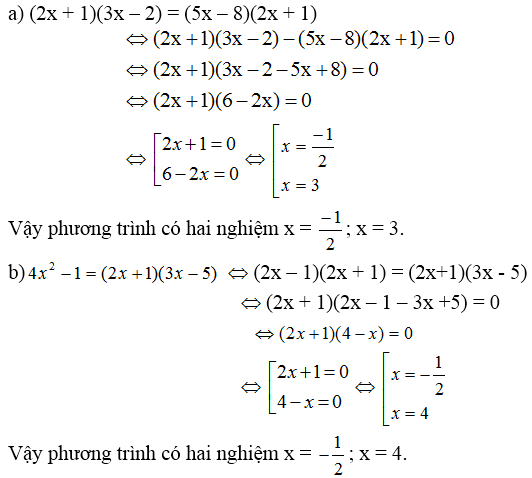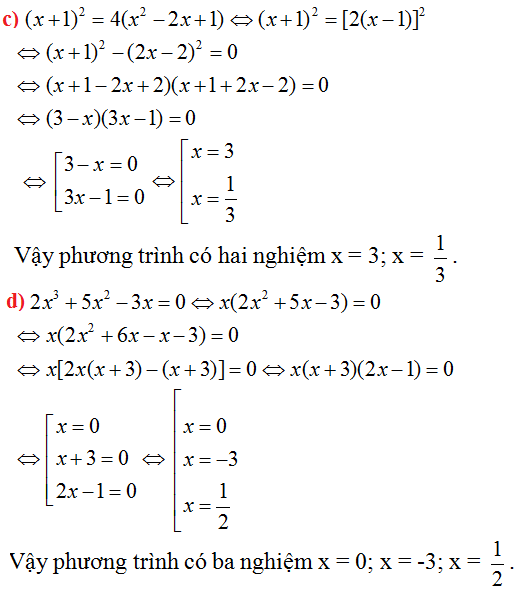Hãy nhập câu hỏi của bạn vào đây, nếu là tài khoản VIP, bạn sẽ được ưu tiên trả lời.

a)(2x+1)(3x-2)=(5x-8)(2x+1)
⇔(2x+1)(3x-2)-(5x-8)(2x+1)=0
⇔(2x+1)(3x-2-5x+8)=0
⇔(2x+1)(-2x+6)=0
⇔2x+1=0 hoặc -2x+6=0
1.2x+1=0⇔2x=-1⇔x=-1/2
2.-2x+6=0⇔-2x=-6⇔x=3
phương trình có 2 nghiệm x=-1/2 và x=3

\(\frac{x^2-x-6}{x-3}=\frac{x^2-3x+2x-6}{x-3}=\frac{x\left(x-3\right)+2\left(x-3\right)}{\left(x-3\right)}=x+2=0\Leftrightarrow x=-2\)
\(\frac{x^2+2x-\left(3x+6\right)}{x+2}=\frac{x\left(x+2\right)-3\left(x+2\right)}{x+2}=x-3=0\Leftrightarrow x=3\)
\(\frac{4}{x-2}-\left(x-2\right)=0\Leftrightarrow\frac{4}{a}-a=0\left(a=x-2\right)\Leftrightarrow\frac{4}{a}=a\Leftrightarrow a^2=4\Leftrightarrow a=\pm2\Leftrightarrow x=4\text{ hoặc 0}\)
a) ĐKXĐ: x \(\ne\)3
Ta có: \(\frac{x^2-x-6}{x-3}=0\)
<=> x2 - x - 6 = 0
<=> x2 - 3x + 2x - 6 = 0
<=> (x + 2)(x - 3) = 0
<=> \(\orbr{\begin{cases}x+2=0\\x-3=0\end{cases}}\)
<=> \(\orbr{\begin{cases}x=-2\\x=3\left(vn\right)\end{cases}}\)
Vậy S = {-2}
b) ĐKXĐ: x \(\ne\)-2
Ta có: \(\frac{\left(x^2+2x\right)-\left(3x+6\right)}{x+2}=0\)
<=> \(x\left(x+2\right)-3\left(x+2\right)=0\)
<=> \(\left(x-3\right)\left(x+2\right)=0\)
<=> \(\orbr{\begin{cases}x-3=0\\x+2=0\end{cases}}\)
<=> \(\orbr{\begin{cases}x=3\\x=-2\left(vn\right)\end{cases}}\)
Vậy S = {3}
c) ĐKXĐ: x \(\ne\)2
Ta có: \(\frac{4}{x-2}-x+2=0\)
<=> \(\frac{4-\left(x-2\right)^2}{x-2}=0\)
<=> \(\left(2-x+2\right)\left(2+x-2\right)=0\)
<=> \(x\left(4-x\right)=0\)
<=> \(\orbr{\begin{cases}x=0\\4-x=0\end{cases}}\)
<=> \(\orbr{\begin{cases}x=0\\x=4\end{cases}}\)
Vậy S = {0; 4}

1 14-3x=-2+5x
<=>-3x-5x = -2-14
<=> -8x =-16
<=> x =-16/-8=2
mấy bạn ơi...các phương trình trên nó bị lặp lại nhak....ptrinh day ni:
a)\(14-3x=-2+5x\)
b) \(3\times\left(5x+2\right)-x\times\left(5x+2\right)=0\)
c) \(\frac{2x}{3}+\frac{3x-1}{6}=4-\frac{x}{3}\)
d) \(\frac{3-x}{x-2}+\frac{x+1}{x+2}=\frac{3x}{x^2-4}\)

\(a,2x\left(x-3\right)+5\left(x-3\right)=0\)
\(\Leftrightarrow\left(2x+5\right)\left(x-3\right)=0\)
\(\Leftrightarrow\orbr{\begin{cases}2x+5=0\\x-3=0\end{cases}}\Leftrightarrow\orbr{\begin{cases}2x=-5\\x=3\end{cases}}\Leftrightarrow\orbr{\begin{cases}x=-\frac{5}{2}\\x=3\end{cases}}\)
Vậy .........
\(b,\left(x^2-4\right)+\left(x-2\right)\left(3-2x=0\right)\)
\(\Leftrightarrow x^2-4-2x^2+7x-6=0\)
\(\Leftrightarrow-x^2+7x-10=0\)
\(\Leftrightarrow-\left(x-5\right)\left(x-2\right)=0\)
\(\Leftrightarrow\orbr{\begin{cases}x=5\\x=2\end{cases}}\)
Vậy ..................
\(c,x^3-3x^2+3x-1=0\)
\(\Leftrightarrow\left(x-1\right)^3=0\)
\(\Leftrightarrow x=1\)
\(d,x\left(2x-7\right)-4x+14=0\)
\(\Leftrightarrow2x^2-7x-4x+14=0\)
\(\Leftrightarrow2x^2-11x+14=0\)
\(\Leftrightarrow\left(2x-7\right)\left(x-2\right)=0\)
\(\Leftrightarrow\orbr{\begin{cases}x=\frac{7}{2}\\x=2\end{cases}}\)
Vậy ............
\(e,\left(2x-5\right)^2-\left(x+2\right)^2=0\)
\(\Leftrightarrow4x^2-20x+25-x^2-4x-4=0\)
\(\Leftrightarrow3x^2-24x+21=0\)
\(\Leftrightarrow3\left(x-7\right)\left(x-1\right)=0\)
\(\Leftrightarrow\orbr{\begin{cases}x-7=0\\x-1=0\end{cases}}\Leftrightarrow\orbr{\begin{cases}x=7\\x=1\end{cases}}\)
Vậy .....................
\(f,x^2-x-\left(3x-3\right)=0\)
\(\Leftrightarrow x^2-x-3x+3=0\)
\(\Leftrightarrow x^2-4x+3=0\)
\(\Leftrightarrow\left(x-3\right)\left(x-1\right)=0\)
\(\Leftrightarrow\orbr{\begin{cases}x-3=0\\x-1=0\end{cases}}\Leftrightarrow\orbr{\begin{cases}x=3\\x=1\end{cases}}\)
Vậy ..............
giải bất phương trình sau :
a , \(\frac{x+1}{x+7}\ge0\)
b , \(\frac{2x-1}{3x+2}< 0\)
cảm ơn trước nhé !

a,TH1:\(\hept{\begin{cases}x+1\ge0\\x+7\ge0\end{cases}}\)\(\Rightarrow\hept{\begin{cases}x\ge-1\\x\ge-7\end{cases}}\)\(\Rightarrow x\ge-1\)
TH2:\(\hept{\begin{cases}x+1\le0\\x+7\le0\end{cases}}\)\(\Rightarrow\hept{\begin{cases}x\le-1\\x\le-7\end{cases}}\)\(\Rightarrow x\le-7\)
Tập nghiệm của BPT là ...
b,TH1:\(\hept{\begin{cases}2x-1< 0\\3x+2>0\end{cases}}\)\(\Rightarrow\hept{\begin{cases}2x< 1\\3x>-2\end{cases}}\)\(\Rightarrow\hept{\begin{cases}x< \frac{1}{2}\\x>-\frac{2}{3}\end{cases}}\)\(\Rightarrow-\frac{2}{3}< x< \frac{1}{2}\)
TH2:\(\hept{\begin{cases}2x-1>0\\3x+2< 0\end{cases}}\)\(\Rightarrow\hept{\begin{cases}2x>1\\3x< -2\end{cases}}\)\(\Rightarrow\hept{\begin{cases}x>\frac{1}{2}\\x< -\frac{2}{3}\end{cases}}\)(loại)
Tập nghiệm của BPT....




\(lim_{x\rightarrow+\infty}\left(\sqrt{ax^2+bx}-cx\right)=-2\)
\(\Leftrightarrow\sqrt{ax^2+bx}-cx=-2\left(x\rightarrow+\infty\right)\)(1)
\(\Leftrightarrow\frac{ax^2+bx-c^2x^2}{\sqrt{ax^2+bx}+cx}=-2\left(x\rightarrow+\infty\right)\)
\(\Leftrightarrow\frac{x\left(ax+b-c^2x\right)}{x\sqrt{a+\frac{b}{x}}+c}=-2\left(x\rightarrow+\infty\right)\)
\(\Leftrightarrow\frac{x\left(a-c^2\right)+b}{\sqrt{a}+c}=-2 \left(x\rightarrow+\infty\right)\)
\(\Rightarrow x\left(a-c^2\right)+b=-2\left(\sqrt{a}+c\right) \left(x\rightarrow+\infty\right)\)
\(\Leftrightarrow a-c^2=\frac{-2\left(\sqrt{a}+c\right)-b}{x}\left(x\rightarrow+\infty\right)\)
\(\Rightarrow a-c^2=0\Leftrightarrow a=c^2\)
Mà \(c^2+a=18\)suy ra \(\hept{\begin{cases}c=\pm3\\a=9\end{cases}}\)
TH1: c=-3;a=9 thì (1) có giới hạn là vô cùng (loại)
TH2: c=3; a=9 thì (1) tương đương
\(\sqrt{9x^2+bx}-3x=-2\left(x\rightarrow+\infty\right)\)
\(\Leftrightarrow\frac{bx}{x\left(\sqrt{9+\frac{b}{x}}+3\right)}=-2\left(x\rightarrow+\infty\right)\)
\(\Leftrightarrow\frac{b}{6}=-2\Rightarrow b=-12\)
\(\Rightarrow a+b+5c=9-12+5.3=12\)
Giả sử cạnh hình vuông là a
\(AM=\frac{a}{2}\)
\(AN=\frac{3a\sqrt{2}}{4}\)
\(MN=\sqrt{\left(2-1\right)^2+\left(-1-2\right)^2}=\sqrt{10}\)
\(Cos\widehat{MAN}=\frac{AM^2+AN^2-MN^2}{2AM.AN}\)
\(\Leftrightarrow\frac{\sqrt{2}}{2}=\frac{\frac{1}{4}a^2+\frac{9}{8}a^2-10}{2.\frac{1}{2}a.\frac{3\sqrt{2}}{4}a}\Rightarrow a=4\)
Giả sử CD: \(\left(d\right):y=ax+b\)
MN cắt CD tại K \(\Rightarrow K\in\left(d\right)\)
Ta có:
\(\Delta MNA\infty\Delta KNC\)
\(\Rightarrow\frac{MN}{NK}=\frac{AN}{NC}=3\)
\(\Leftrightarrow\overrightarrow{MN}=3\overrightarrow{NK}\Rightarrow K\left(\frac{7}{3};-2\right)\)
Do \(K\in\left(d\right)\Rightarrow7a+3b=-6\)(1)
Viết lại \(\left(d\right):ax-y+b=0\)
\(d_{\left(M,\left(d\right)\right)}=4\Rightarrow\frac{\left|a-2+b\right|}{\sqrt{a^2+1}}=4\Leftrightarrow\left(a-2+b\right)^2=16\left(a^2+1\right)\)(2)
Từ (1) và (2) \(\hept{\begin{cases}a=0\\b=-2\end{cases}}\)hoặc \(\hept{\begin{cases}a=\frac{3}{4}\\b=-\frac{15}{4}\end{cases}}\)
\(\Rightarrow\orbr{\begin{cases}\left(d\right):y+2=0\\\left(d\right):3x-4y-15=0\end{cases}}\)